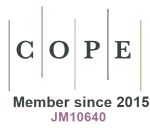Downloads
How to Cite
Anile, M., Chiappetta, C., Diso, D., Liparulo, V., Leopizzi, M., Rocca, C. D., & Venuta, F. (2014). Influence of Lung Parenchyma Surgical Manipulation on Circulating Free DNA. Journal of Circulating Biomarkers, 3(1). https://doi.org/10.33393/jcb.2014.2048
Issue
Section
Original research article
Statistics
- Abstract views - 604 times
- PDF downloads - 358 times
Sign up
banners150
Most popular articles in the last 30 days
-
198
-
194
-
175
-
154
-
109









